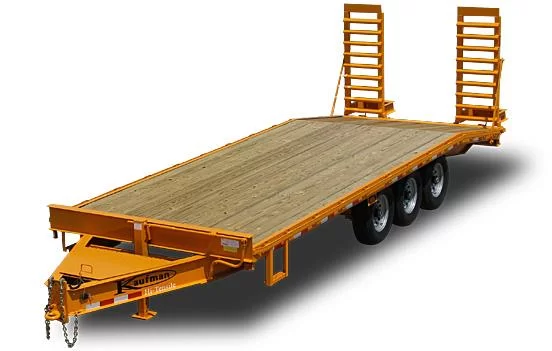Flatbed Trailer Types: How to Pick the Right Model for Your Needs
Choosing a flatbed trailer can be difficult because it’s such a broadly used term within the hauling industry. Even different manufacturers and suppliers have different definitions or limitations on what can be considered a flatbed trailer, making it even harder for consumers to find exactly what they need.
Let Kaufman Trailers help you make an informed decision and find the trailer that fits your requirements perfectly.
Whether you need a trailer for hauling heavy equipment, vehicles, or materials, finding the perfect match is crucial for efficiency and safety. In this guide, our flatbed trailer experts are exploring the various flatbed trailer types. Join us as we provide insights on selecting the ideal model for your specific needs.
What is a Flatbed Trailer?
A flatbed trailer is a versatile and essential piece of equipment in the transportation industry. Unlike enclosed trailers, flatbed trailers feature an open design without sides or a roof, allowing for easy loading and unloading of various types of cargo. This flexibility makes them ideal for transporting oversized, heavy, or irregularly shaped items that might not fit into standard enclosed trailers.
Understanding what a flatbed trailer is and how it functions can help you determine if it’s the right choice for your hauling needs.
Popular Flatbed Trailer Types
Flatbed trailers come in a variety of types, each designed to handle specific hauling needs. From transporting heavy machinery to moving construction materials, the right flatbed trailer can make a significant difference in the efficiency and safety of your operations.
Standard Flatbed Trailer
A standard flatbed trailer is the most versatile and widely used type, featuring a flat deck without sides or a roof. It is ideal for transporting a variety of cargo, including lumber, construction materials, machinery, and large equipment. This flexibility makes it a favorite among general contractors, construction companies, and logistics providers who need to haul materials of varying sizes and shapes.
Gooseneck Trailer
Flatbed trailer types with a gooseneck hitch come up and out from the trailer with a long, curved neck, allowing it to affix to a truck or towing vehicle. Gooseneck hitch trailers fall under the flatbed classification because the deck is over the tires. Many of Kaufman’s gooseneck flatbed trailer types are built with a cold formed, one-piece frame and tongue that comes together at the front of the trailer. The tongue is joined to a flat plate or an adjustable mounting rack with holes to attach either a pintle ring or ball hitch.
Our many gooseneck flatbed trailers offer a broad range of “pintle ring hitch” models starting at 14,000 gross vehicle weight rating (the maximum amount of weight the trailer can hold and transport, also called GVWR) and going all the way up to a tri-axle airbrake model with a 62,000 GVWR.
Gooseneck trailers are known for their stability and ability to handle heavy loads and providing better weight distribution and maneuverability. These trailers are perfect for transporting large loads such as agricultural equipment, livestock, and construction materials. Farmers, ranchers, and construction contractors often prefer gooseneck trailers for their strength and versatility.
Drop Deck Trailer
Drop deck trailers, also known as step deck trailers, feature a lower deck that allows for transporting taller loads that exceed the height limits of standard flatbed trailers. They are perfect for hauling heavy machinery, construction equipment, and oversized items. This type is particularly useful for industries that need to move tall or bulky goods without the restrictions of height regulations.
A deckover design means that the trailer bed, also called a deck or platform, is over the tires. All flatbed trailer types have this feature, from the smallest to largest models. Deckover design flatbed trailers often have stake pockets with a rub rail down the outer edges, though there may be a heavy channel rail included instead. With a channel rail, the “c” is turned out, allowing bent d-rings installed down the length of the trailer to be used to tie down equipment.
This system is highly reliable and used by nearly all over-the-road semi trailers.
Heavy Equipment Trailer
Heavy equipment trailers are built to transport extremely heavy and oversized machinery, such as bulldozers, excavators, and industrial equipment. These trailers are robust and designed to handle substantial weight, making them ideal for construction companies, mining operations, and heavy industry contractors who need to move large equipment between job sites.
Paver Flatbed Trailer
Paver flatbed trailers are specifically designed for transporting paving equipment and related machinery. With a low-profile deck and ramps, they make loading and unloading pavers, asphalt rollers, and other paving equipment easy. These trailers are essential for paving contractors and road construction companies, ensuring efficient and safe transportation of paving machinery to job sites.
Detachable Low Boy Trailer
Detachable low boy trailers have a detachable front that allows the trailer to be lowered to the ground, enabling easy loading and unloading of heavy equipment. They are ideal for transporting large construction machinery, agricultural equipment, and other heavy-duty items. Contractors and industries that frequently move heavy equipment benefit greatly from the ease of access provided by detachable low boy trailers.
Choosing a Flatbed Frame
At Kaufman Trailers, we match the frame and running gear of every flatbed trailer to ensure optimal compatibility of all the components. We use two types of frame construction to build our flatbeds: stacked frame construction and pieced beam.
Stacked Frame Construction
The cross members of this flatbed trailer frame are welded to the top of the mainframe beams with outer rails. Then, stake pockets are welded on and then the rub rail is installed on the outside of the stake pockets. Our flatbed trailer experts use this method of manufacturing with both our standard and deluxe version of the 14,000 GVWR flatbed trailer. The standard model has two 7,000 pound axles with an 8-inch I-beam frame while the deluxe model upgrades the frame to a 10-inch I-beam.
Pieced Beam
The pieced beam construction method of this flatbed trailer type is a more reliable, durable method. Our trailer supply company uses this frame construction on many of our heavy-duty, deluxe flatbed trailers. This method requires the mainframe beams to be pierced to the shape of the channel crossmembers, allowing the crossmembers to slide through. Once in place, the crossmembers are welded back into one unit.
At Kaufman Trailers, we use the pierced beam method of construction with our “pintle pull” flatbed trailers which are built with two or three 10,000 lb. electric brake axles and have a 25,900 GVWR on two axles and 38,500 lb. on three axles. We also use this frame construction method for flatbed trailers on our airbreak flatbeds that offer up to 70,000 GVWR.
Tips for Choosing the Right Flatbed Trailer Types
Our flatbed trailer specialists understand it can be difficult to choose the right trailer for your needs, especially with so many models to choose from. Plus, flatbed trailers range in size and functionality, from small, tandem axle models to 48-foot flatbeds pulled by an 18-wheeler, and more.
Choosing the right flatbed trailer type involves considering several key factors:
- Cargo Type: Identify the type of cargo you are transporting to find the best trailer for your freight. This includes size, weight, and shape. This helps determine the necessary trailer size and weight capacity.
- Frequency of Use: Consider how often you’ll use the trailer. Frequent use may require a more durable and higher-quality model.
- Terrain and Travel Distance: Think about the typical routes and terrain. Some trailers are better suited for long distances or rough roads.
- Budget: Determine your budget, balancing cost with the quality and features you need.
- Regulatory Requirements: Ensure the trailer meets all local and national regulations for your intended use.
Shop Our Inventory of Flatbed Trailer Types at Kaufman Trailers
If you are looking for a durable, reliable flatbed trailer that improves loading and unloading, we can help. Explore our extensive inventory at Kaufman Trailers and discover top-quality options tailored to your specific requirements. Our experienced staff will match your hauling needs to a perfect flatbed trailer.
Shop now and experience the difference in durability and performance with Kaufman Trailers. Get started today by calling our experts in towing vehicles at 866-455-7444 or by filling out the online contact form below.
 Kaufman Trailers
Kaufman Trailers
